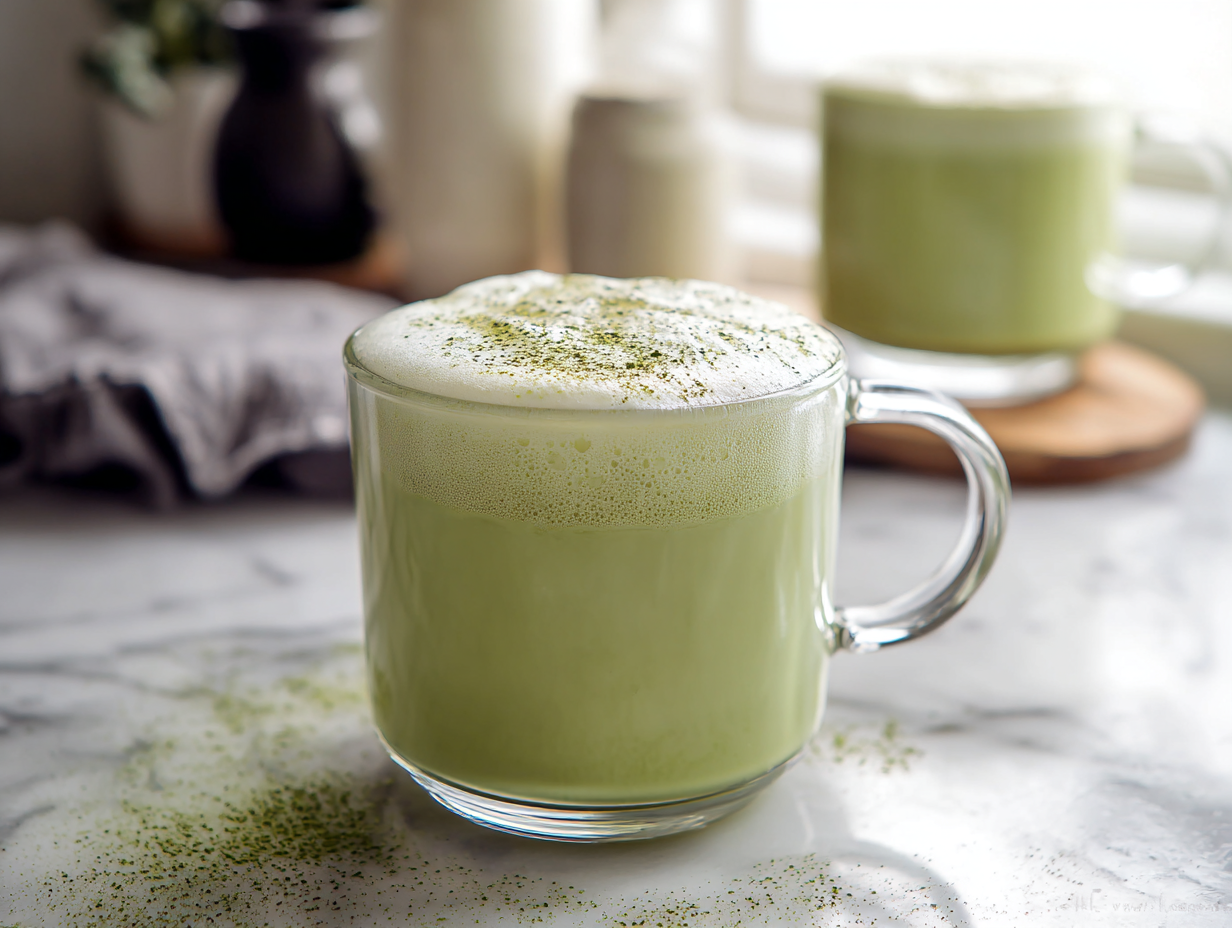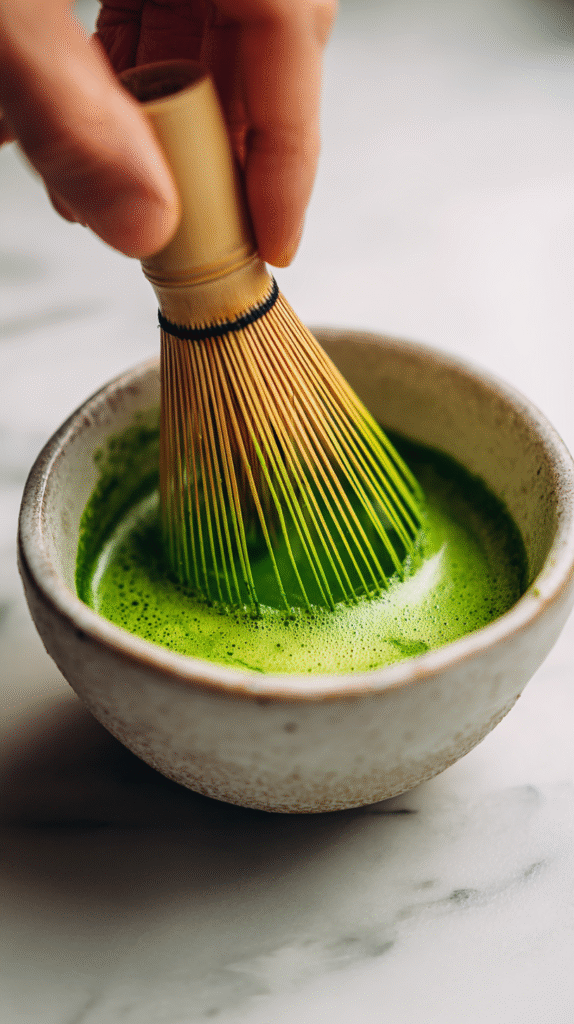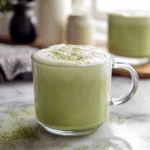There’s something magical about sitting down with a warm cup that feels like both comfort and energy in a mug. That’s exactly what a matcha latte gives me every morning. Its bright green color, earthy flavor, and creamy foam make it more than just a drink—it’s a ritual. In this article, I’ll share the story of how I first fell for matcha, the surprising benefits behind this green tea powder, and how you can easily recreate a Starbucks-style matcha latte at home.
We’ll cover everything from health perks to low-calorie swaps, and I’ll walk you through a simple recipe that’s dairy-free, naturally sweetened, and downright delicious.
My First Sip of Matcha Latte
My love for matcha latte started on a chilly autumn morning in Asheville. I’d wandered into a little café tucked between the mountains, hoping for something other than my usual black coffee. The barista handed me a frothy green drink, dusted with a little extra powder on top. I’ll be honest—I wasn’t sure what to expect. But that first sip surprised me. It was creamy, slightly grassy, sweet without being overpowering, and so soothing that I felt an instant calm settle in.
From that day, matcha latte became my go-to when I wanted both energy and comfort. Unlike coffee, which often left me jittery, matcha gave me a steady focus. As a mom and former teacher, I needed that kind of calm energy to get through long days. Soon, I was making it at home, experimenting with dairy-free milks and natural sweeteners, until I found the balance that felt just right.
For me, it wasn’t just about the taste. It reminded me of afternoons with my grandmother, sipping sweet tea and learning how food could be both nurturing and joyful. Now, I pass that same ritual down to my kids, who sometimes join me with their own small mugs of warm almond milk.
If you’ve ever found comfort in a cozy drink, you’ll understand why I keep returning to my whisk and matcha tin. It’s the same feeling I chase when baking keto chocolate muffins on weekends or simmering a pot of lasagna soup for dinner. These little traditions create peace in a busy world—and that’s exactly what a good matcha latte does.
Matcha Latte Benefits & Myths
Can Matcha Latte Help You Lose Weight?
One of the most common questions people ask me is whether a matcha latte can actually help with weight loss. The short answer is: it can play a supportive role. Matcha is packed with catechins, a type of antioxidant that boosts metabolism and supports fat burning. Unlike coffee, which gives you a fast jolt, matcha offers a gentler caffeine lift that pairs with L-theanine to promote calm focus. That steady energy can reduce sugar cravings and help you avoid the afternoon slump that often leads to snacking.
Of course, the way you prepare your matcha latte makes a big difference. If you load it with syrups and heavy cream, the extra calories can offset the benefits. But when you keep it simple—using non-dairy milk and a touch of honey or maple syrup—it becomes a light, nourishing drink that supports your goals. I’ve found it especially helpful during times when I want a warm, comforting drink but don’t want to reach for another sugary option. It’s the same balance I aim for when I make light meals like this healthy beef and pepper rice bowl—satisfying but not heavy.
Are Matcha Lattes Healthy?
The health perks of a matcha latte go beyond weight loss. Matcha is incredibly rich in antioxidants, containing more than ten times the amount found in regular green tea. These compounds support heart health, brain function, and even glowing skin. Plus, when whisked into warm milk, matcha becomes a soothing ritual that benefits both body and mind.
The key to keeping it healthy lies in your choice of ingredients. Unsweetened almond, oat, or soy milk all pair beautifully with the earthy flavor of matcha. A small drizzle of maple syrup or honey adds sweetness without refined sugar. I often compare it to making a purple juice blend—when you let natural ingredients shine, you don’t need much else.
So yes, matcha lattes are healthy, as long as you keep them simple, mindful, and part of a balanced diet.
How to Make a Matcha Latte with Fewer Calories
One of the best parts about making your own matcha latte at home is having full control over what goes into your cup. If you’re watching calories, there are a few simple swaps that make a big difference without sacrificing flavor. Start with an unsweetened non-dairy milk like almond or oat—it cuts down on both calories and sugar compared to whole milk. Next, use just a teaspoon of natural sweetener, or skip it entirely if you enjoy the grassy flavor of matcha on its own.
Another easy trick is frothing your milk well. A light, foamy top makes the drink feel indulgent, even though it’s lighter than a store-bought version. When I want something extra cozy but still mindful, I treat myself to this low-carb taco soup. Just like a lighter matcha latte, it proves that comfort food doesn’t need to be heavy to be satisfying.
Is Matcha Better with Water or Milk?
This question really comes down to personal preference. Traditionally, matcha is whisked with hot water only, creating a bold, slightly bitter tea. It’s simple, clean, and highlights the earthy flavor. Adding milk, on the other hand, softens that sharpness and turns it into a creamy, café-style drink.
If you’re aiming for a low-calorie option, water is the clear winner. But if you want something smooth and comforting, milk—especially dairy-free alternatives—makes the matcha more approachable. I often switch between the two depending on the day: water for mornings when I need focus, milk for afternoons when I want to unwind.
It’s the same way I think about recipes like sugar-free pumpkin muffins. Sometimes you want the lighter version, sometimes the cozy one—it just depends on what you’re craving.
Variations & Serving Ideas
Iced Matcha Latte for Warm Days
When the weather turns warm, nothing hits the spot quite like an iced matcha latte. It’s refreshing, energizing, and surprisingly easy to make at home. Simply whisk your matcha with a splash of hot water until smooth, then pour it over ice with cold milk of your choice. A drizzle of honey or agave adds just enough sweetness without weighing it down.
The beauty of an iced matcha latte is that it feels indulgent while still being light. On hot afternoons, I often make a glass to sip while the kids snack on something simple, like these apple pie energy balls. Together, they make a snack break that’s nourishing and uplifting.
Cozy Hot Matcha Latte for Relaxation
Of course, nothing beats a steaming hot matcha latte on a chilly day. The warmth of the milk, the frothy top, and that earthy green tea flavor make it feel like a hug in a cup. I usually prepare it with oat milk for creaminess, whisking it until the foam piles high. It’s the kind of drink I love to enjoy in the evenings, especially when I want to wind down with a book.
Sometimes I’ll pair it with a homemade treat, like this banana bread with almond flour. The nutty sweetness of the bread balances beautifully with the grassy, comforting tones of matcha. Together, they turn a simple moment into something truly special.
Whether iced or hot, the versatility of a matcha latte is what keeps me coming back. It adapts to the seasons, to cravings, and even to moods—making it the kind of drink that fits seamlessly into everyday life.
FAQs About Healthy Matcha Latte
Can matcha latte help you lose weight?
Yes, matcha lattes can support weight loss when made with light ingredients. Matcha contains catechins, antioxidants that help boost metabolism and fat burning. When paired with unsweetened milk and minimal sweetener, it becomes a low-calorie drink that keeps you energized and helps reduce cravings.
Are matcha lattes healthy?
Absolutely. Matcha is loaded with antioxidants, more than regular green tea, which support brain health, heart health, and skin vitality. When combined with non-dairy milk and natural sweeteners, a matcha latte is a nutrient-rich drink that fits well into a balanced lifestyle.
How to make a matcha less calories?
To make a lower-calorie matcha latte, use unsweetened almond or oat milk, skip heavy syrups, and sweeten lightly with honey or stevia. Frothing the milk creates a creamy texture without adding extra calories, making the drink feel indulgent but light.
Is matcha better with water or milk?
It depends on your preference. Matcha with water is the traditional method, producing a strong, earthy tea. With milk, matcha becomes creamier and softer in flavor, ideal for those who prefer a smoother drink. For a low-calorie option, water is best; for a cozy treat, milk is the way to go.
Conclusion
For me, a matcha latte isn’t just a drink—it’s a small ritual that brightens my day. From its calming energy to its vibrant green color, this cozy cup brings both comfort and nourishment. Whether you enjoy it iced on a sunny afternoon or hot on a chilly evening, it adapts to every season and mood. With just a few simple ingredients, you can create a Starbucks-style matcha latte at home that’s healthier, dairy-free, and naturally sweetened. So grab your whisk, warm your favorite mug, and enjoy a moment of calm in every sip.
Please let me know how it turned out for you! Leave a comment below and tag @foodiecreator on Instagram and hashtag it #foodiecreator.
PrintHealthy Matcha Latte Starbucks Copycat Recipe
- Total Time: 10 minutes
- Yield: 2 servings 1x
Description
This Healthy Matcha Latte is creamy, dairy-free, naturally sweetened, and packed with antioxidants. A Starbucks copycat recipe you can make at home in just 10 minutes.
Ingredients
3 cups milk (dairy-free if desired)
2 tablespoons honey, maple syrup, or agave nectar
A few drops vanilla extract
5–6 teaspoons matcha green tea powder
2–3 tablespoons hot water
Instructions
1. Heat the milk in a small pot until it simmers.
2. Whisk in the honey (or sweetener) and vanilla until combined and frothy.
3. Add matcha powder to a small bowl and stir with hot water to form a paste.
4. Pour the sweetened milk over the diluted matcha.
5. Top with foam and serve warm, or refrigerate and reheat later.
Notes
Use almond, oat, or soy milk for a vegan version.
Adjust sweetness to taste.
For iced matcha latte: let milk cool, pour over ice, then add whisked matcha paste.
- Prep Time: 5 minutes
- Cook Time: 5 minutes
- Category: Drinks, Breakfast
- Method: Stovetop
- Cuisine: Japanese, American
Nutrition
- Serving Size: 1 cup
- Calories: 90
- Sugar: 10g
- Sodium: 40mg
- Fat: 2g
- Saturated Fat: 0.5g
- Unsaturated Fat: 1.5g
- Trans Fat: 0g
- Carbohydrates: 15g
- Fiber: 2g
- Protein: 3g
- Cholesterol: 0mg





